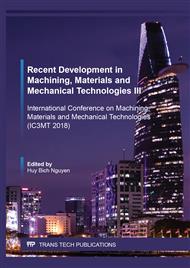[1]
H.T. Yau, C.Y. Chen, R.G. Wilhelm, Registration and integration of multiple laser scanned data for reverse engineering of complex 3D models, Int J Prod Res, 38(2), 2000, p.269–85.
DOI: 10.1080/002075400189400
Google Scholar
[2]
H.P. Son, K.H. Lee, Automated laser scanning system for reverse engineering and inspection, Int J Mach Tool Manu, 42, 2002, p.889–97.
Google Scholar
[3]
J. Pages, J.J. Salvi, R. Garcia, C. Matabosch, Overview of coded light projection techniques for automatic 3D profiling, IEEE International Conference on Robotics & Automation, (2003).
DOI: 10.1109/robot.2003.1241585
Google Scholar
[4]
C. Hernández, F. Schmitt, Silhouette and stereo fusion for 3D object modeling, Computer Vision and Image Understanding, 96(3), 2004, pp.367-392.
DOI: 10.1016/j.cviu.2004.03.016
Google Scholar
[5]
S. Sinha, M. Pollefeys, Multi-view reconstruction using photo-consistency and exact silhouette constraints: a maximum flow formulation, ICCV, (2005).
DOI: 10.1109/iccv.2005.159
Google Scholar
[6]
A.Y. Mulayim, U. Yilmaz, V. Atalay, Silhouette-based 3D model reconstruction from multiple images, IEEE Transactions on Systems, Man and Cybernetics, part B 33(4), 2003, pp.582-591.
DOI: 10.1109/tsmcb.2003.814303
Google Scholar
[7]
Y. Yemez, Y. Sahilioglu, Shape from silhouette using topology-adaptive mesh deformation, Pattern Recognition Letters, 2009, pp.1198-1207.
DOI: 10.1016/j.patrec.2009.05.012
Google Scholar
[8]
C. Rocchini, P. Cignoni, F. Ganovelli, C. Montani, P. Pingi, R. Scopigno, The marching intersections algorithm for merging range images, The Visual Computer, 20(2), 2004, pp.149-64.
DOI: 10.1007/s00371-003-0237-8
Google Scholar
[9]
W. Matusik, C. Buehler, L. Mcmillan, Polyhedral visual hulls for real-time rendering, Rendering Techniques Part of the Series Eurographics, 2001, pp.115-125.
DOI: 10.1007/978-3-7091-6242-2_11
Google Scholar
[10]
W. Niem, R. Buschmann, Automatic modelling of 3D natural objects from multiple views, Image Processing for Broadcast and Video Production, Workshops in Computing, 1995, pp.181-193.
DOI: 10.1007/978-1-4471-3035-2_15
Google Scholar
[11]
H. Biermann, I. Martin, F. Bernardini, D. Zorin, Cut-and-paste editing of multiresolution surfaces, In ACM Transactions on Graphics, 21(3), 2002, pp.312-321.
DOI: 10.1145/566654.566583
Google Scholar
[12]
O. Sorkine, D. Cohen-Or, Y. Lipman, M. Alexa, C. Rössl, H. P. Seidel, Laplacian surface editing, In Proceedings of the 2004 Eurographics/ACM SIGGRAPH symposium on Geometry processing, 2004, pp.175-184.
DOI: 10.1145/1057432.1057456
Google Scholar
[13]
B. Lévy, Dual domain extrapolation, ACM Transactions on Graphics, 22(3), 2003, pp.364-369.
DOI: 10.1145/882262.882277
Google Scholar
[14]
Y. Yu, K. Zhou, D. Xu, X. Shi, H. Bao, B. Guo, H.Y. Shum, Mesh editing with poisson-based gradient field manipulation. ACM Transactions on Graphics, 23(3), 2004, pp.644-651.
DOI: 10.1145/1015706.1015774
Google Scholar
[15]
D. Zorin, P. Schröder, W. Sweldens, Interactive multiresolution mesh editing, In Proceedings of the 24th annual conference on Computer graphics and interactive techniques, 1997, pp.259-268.
DOI: 10.1145/258734.258863
Google Scholar
[16]
Blender Online Community, Blender - a 3D modelling and rendering package, Blender Foundation, 2018, http://www.blender.org.
DOI: 10.1007/978-1-4302-1977-4_1
Google Scholar
[17]
P. Cignoni, M. Callieri, M. Corsini, M. Dellepiane, F. Ganovelli, G. Ranzuglia, Meshlab: an open-source mesh processing tool, In Eurographics Italian Chapter Conference, 2008, pp.129-136.
Google Scholar
[18]
C. Y. Liao, Y. S. Xiong, D. W. Wang, J. Y. Lai, J. Y. Lee, A camera calibration process for 3D digital model reconstruction of huge objects, 2016 Machining, Materials and Mechanical Technologies, Japan, (2016).
Google Scholar


